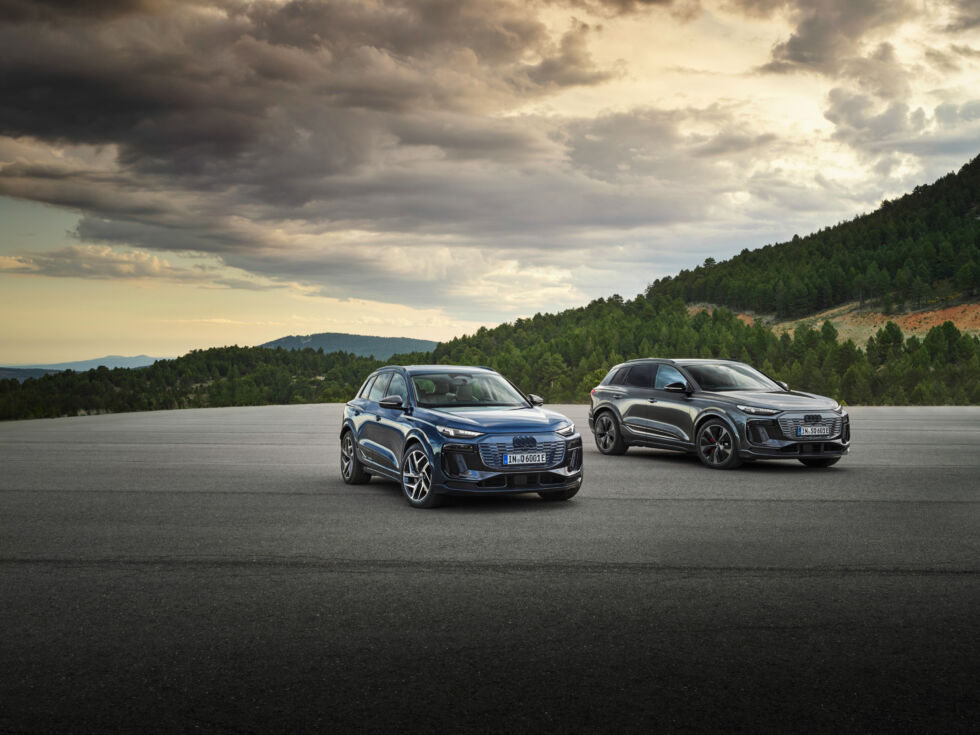A more efficient powertrain
PPE EVs will be either rear- or all-wheel drive, and the rear drive unit is an evolution of the design you can find in a Porsche Taycan or Audi e-tron GT.
There's a permanent synchronous motor, and the inverter now uses silicon carbide rather than silicon to decrease switching losses and increase switching frequency. And the cooling oil is now dry-sumped, which Audi engineers say increases range by up to 5 km as there's less thermal loss than a wet-sump design. The motors are intended to be quieter and more refined in operation, with less lower-frequency noise than earlier designs.
The front drive unit uses an asynchronous motor design, which means there's no need for a decoupler, as it won't drag while coasting. ASM motors need to be electrically energized to work, and they aren't as efficient as PSMs, so Audi is only using them as boost motors here, it says.
Some of the motor outputs that Audi gave us in Germany only apply to European-spec Q6 e-trons, but here in the US, we're starting with two powertrain options. The Q6 e-tron quattro has 422 hp (315 kW) but can be overboosted in launch control to 456 hp (340 kW), which should allow it to reach 60 mph from a toll booth in 5 seconds. Audi has yet to complete the EPA efficiency estimate process but says it should be over 300 miles (482 km).

There's also an SQ6 e-tron, which is all-wheel-drive as well. This one has 483 hp (360 kW), with up to 510 hp (380 kW) boosts that shave 0.7 seconds off that 0–60 time. A range estimate for the SQ6 should be available later this year, along with the all-important pricing. And it seems Audi is yet another automaker that now doesn't provide a combined torque output for its new EVs, so we can't tell you how torquey either variant will be. In the future, the North American market should get a rear-wheel-drive, single-motor Q6, and Audi all but confirmed an RS version in time, but don't hold out hopes for the smaller battery pack, we're told.
A software-defined car
The Q6 e-tron is an early example of a new trend in automotive design that ditches the dozens of discrete black boxes and consolidates their functions on a small number of domain controllers. The approach is known as the "software-defined car," and the specific digital architecture in the Q6 e-tron is known as E3 1.2. Getting this right has taken longer than VW Group thought. Its software division got a little overambitious trying to develop E3 1.2 and its replacement at the same time before putting aside that more advanced project to concentrate on the stuff it needed to ship.
-
A curved panel surrounds the driver.Audi
-
You can have a sportier cockpit if you choose.Audi
-
The optional passenger infotainment screen.Audi
-
The volume control remains entirely physical.Audi
-
The controls on the door.Audi
There are five domain controllers—Audi is calling them HCPs, for "high-performance computing platform"_ and the company isn't disclosing the chipmaker. HCP1 is responsible for vehicle dynamics, and HCP2 deals with the driver assists. HCP3 runs the infotainment, which uses an Android Automotive OS. The car's convenience functions are handled by HCP4, and there's a backbone computer (HCP5) that ties it all together over Ethernet.
Audi says all the domain controllers are on VLANs with a separate connectivity module and that the car's data should be kept separate from broadcast domains. (Of course, with modern software "consent," we often agree to share data we don't realize we're sharing.)
A brief play with the infotainment system revealed pretty good voice recognition. Audi has developed this together with Cerence, opting not to use Google's Automotive Services or Google's cloud. "Hey Audi" is the trigger phrase, and it lets you control the infotainment, the climate, driver assistance settings, and car functions. It's a hybrid natural-language processing approach that goes online if the offline voice detection needs help.
reader comments
137